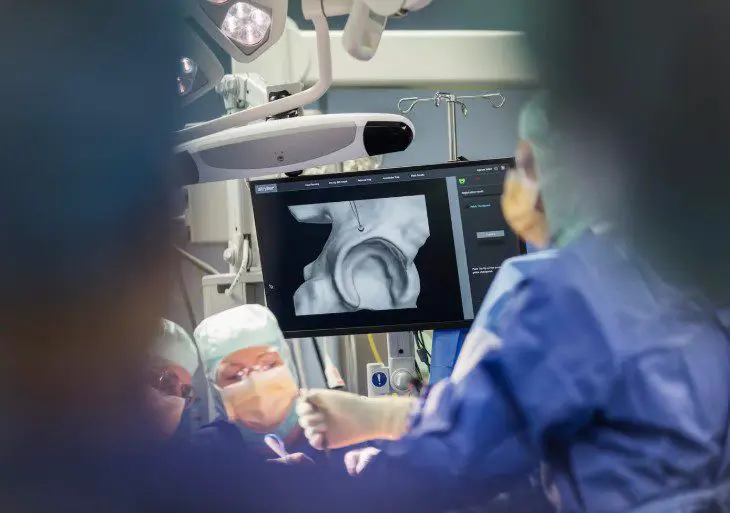
The Mako robot has been established in prosthetics for 18 years and has been continuously developed since then. There are now more than 300 published scientific studies, more than 1,500 Mako systems are in use worldwide and over 1,000,000 procedures have been performed.
Worldwide experience with MAKO technology
The MAKO technology we use has been around since 2006 and we now have over 15 years of clinical experience. At first, “only” partial knee prostheses could be operated on. Later, hip prosthetics were added and finally, in 2016, the option of implanting a total knee prosthesis. Today, over 1,500 of these MAKO surgical robots are in use worldwide and over 1,000,000 prosthesis implants have already been performed. It is therefore an established form of therapy.
At articon, we have been using the technology since 2018 and have performed over 3,000 MAKO operations at the Bern Prosthetics Center to date. Based on our positive experience, robotic assistance is now the standard procedure for the implantation of partial knee, total knee and hip prostheses and is used in over 95% of operations. Since 2024, we have also been able to perform prosthesis replacement operations using robotic technology.
Additional risks?
In the critical analysis of our own MAKO operations, no specific risks or complications have arisen from the use of robot technology to date. The MAKO system itself shows the expected high reproducibility and extremely low susceptibility to errors. We can show that the risk of complications and in particular second operations on the operated joint is even reduced by the MAKO technology. This effect has also been demonstrated in the specialist literature. However, there is still little or no long-term data over more than 10 years for total knee and hip prostheses. However, as the system is based on well-known and established prosthesis models that show excellent results in international prosthesis registers over a service life of 10 years, no specific risk can be assumed based on current knowledge
In the initial period following the introduction of robotic technology in our practice, bone fractures in the thigh where the bone markers were placed for navigation occurred very rarely. We adjusted the positioning accordingly and have now been able to avoid this complication.
Is there a learning curve?
The learning curve is limited to learning the new sequence of surgical steps because of the surgical robot, which takes a little more time at the beginning. We now have so much experience with the system that our operating time has even been reduced compared to the era before the introduction of robotics.
There is also a certain learning curve regarding optimal decision-making during surgery with the numerous parameters that technology now makes available to the surgeon. Wrong decisions can be made here that have a negative impact on the outcome. This can often only be fully and correctly understood by the specialist. In recent years, we have carried out numerous research projects on “optimal” prosthesis positioning and balancing of the joint using robot technology and are international pioneers in this field. As our patient, you can now benefit from this wealth of experience.
Why doesn’t “everyone” operate with the robot?
The current disadvantages of the technology lie more with the clinic and users than with the patients. Of course, the machine means more technical and logistical effort for us. This applies to maintenance, organization and even the actual operation, where setting up and setting up the system takes a little more time. This additional effort is only worthwhile if the number of cases is high enough for all processes to be optimized for the robot. We perform over 500 robot-assisted procedures per site every year, so we have these disadvantages well under control. For units with a lower degree of specialization, however, the additional expense is often not worthwhile.
Another disadvantage of the technology is the cost of the robot (investment and maintenance) and the consumables required for each procedure. This results in additional costs for us and the clinic that are currently not covered by the payers. This is mainly due to the novelty of the system in Switzerland and the lack of proof that there will also be an economic benefit in the long term by reducing complications and errors. As the pioneers of the technology, this is precisely what we have to provide for Switzerland.
For patients with general insurance, we have to charge a payment of CHF 1200 for the technology to cover the costs of this latest technology during the operation. The amount is charged as a one-off innovation fee, which does not conflict with the legally guaranteed tariff protection.
There are no additional costs for patients with supplementary insurance (semi-private or private), the robot arm-assisted MAKO technique is covered by your insurance/health insurance.